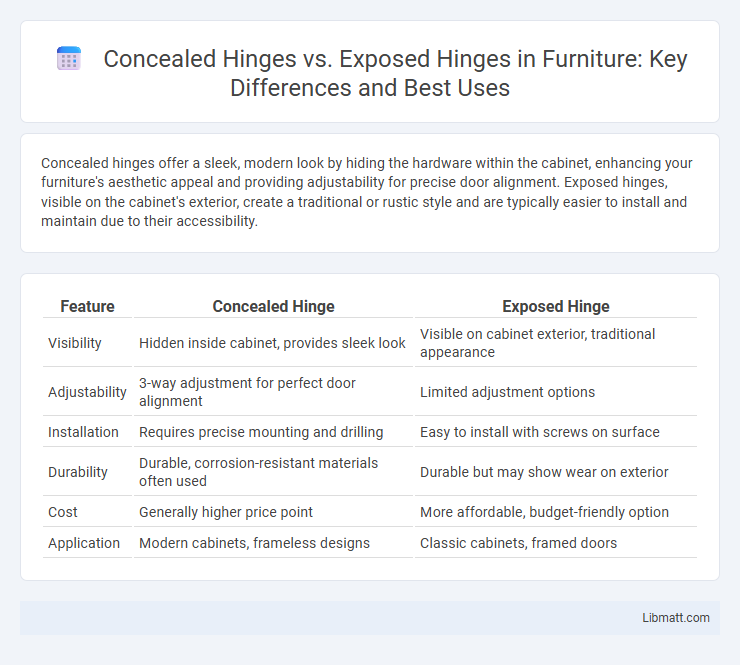Concealed hinges offer a sleek, modern look by hiding the hardware within the cabinet, enhancing your furniture's aesthetic appeal and providing adjustability for precise door alignment. Exposed hinges, visible on the cabinet's exterior, create a traditional or rustic style and are typically easier to install and maintain due to their accessibility.
Table of Comparison
| Feature | Concealed Hinge | Exposed Hinge |
|---|---|---|
| Visibility | Hidden inside cabinet, provides sleek look | Visible on cabinet exterior, traditional appearance |
| Adjustability | 3-way adjustment for perfect door alignment | Limited adjustment options |
| Installation | Requires precise mounting and drilling | Easy to install with screws on surface |
| Durability | Durable, corrosion-resistant materials often used | Durable but may show wear on exterior |
| Cost | Generally higher price point | More affordable, budget-friendly option |
| Application | Modern cabinets, frameless designs | Classic cabinets, framed doors |
Introduction to Concealed and Exposed Hinges
Concealed hinges, often used in modern cabinetry, are hidden from view when doors are closed, providing a clean and sleek appearance while allowing for adjustable alignment. Exposed hinges are visible from the outside, typically featuring decorative designs that contribute to the overall aesthetic of furniture or doors. Both hinge types play crucial roles in functionality and style, with concealed hinges favored for minimalist designs and exposed hinges preferred for traditional or rustic looks.
What Are Concealed Hinges?
Concealed hinges are hardware components designed to remain hidden when a cabinet door is closed, offering a clean and seamless look that enhances modern kitchen and furniture aesthetics. These hinges are mounted inside the cabinet frame and door, providing adjustable alignment for precise door positioning. Choosing concealed hinges improves Your cabinetry's functionality by enabling smooth operation without visible metal parts.
What Are Exposed Hinges?
Exposed hinges are visible hardware components that attach doors or cabinets to a frame, offering both functional support and decorative elements. They come in various styles and finishes, allowing you to customize the look of your furniture or doors while maintaining durability. Choosing exposed hinges can enhance the aesthetic appeal of traditional or rustic designs, making them a popular choice where the hinge itself contributes to the overall decor.
Aesthetic Differences Between Concealed and Exposed Hinges
Concealed hinges offer a sleek, minimalist look by hiding the hardware entirely within the cabinet, maintaining clean lines and modern aesthetics. Exposed hinges add a decorative element to furniture, often showcasing intricate designs or a vintage vibe that enhances traditional or rustic styles. Your choice between concealed and exposed hinges can significantly impact the visual appeal and overall style of your cabinetry or furniture.
Installation Process: Concealed vs Exposed Hinges
Concealed hinges require precise mortising into the cabinet frame and door for a flush fit, often demanding specialized tools and skills for accurate alignment. Exposed hinges install directly onto the surface with visible screws, offering a quicker and simpler installation suitable for DIY projects. The choice between these hinges affects both aesthetic outcomes and installation complexity, with concealed hinges emphasizing a seamless look and exposed hinges providing ease of mounting.
Durability and Longevity Comparison
Concealed hinges offer superior durability due to their protected placement inside the cabinet, reducing exposure to dust, moisture, and physical damage, which enhances their longevity. Exposed hinges, while easier to maintain and replace, are more vulnerable to corrosion and wear from environmental factors, potentially leading to a shorter lifespan. High-quality concealed hinges made from stainless steel or brass typically outlast exposed hinges, making them a preferred choice for long-term use in kitchens and furniture.
Functionality and Practical Applications
Concealed hinges provide a sleek, modern look by hiding hardware within the cabinet, enhancing aesthetics while allowing smooth, silent door operation, ideal for kitchens and bathrooms where appearance is key. Exposed hinges offer easy access for adjustments and maintenance, making them practical for heavy-use or rustic furniture where durability and straightforward installation matter. Your choice depends on whether you prioritize seamless design or functional accessibility in daily use.
Cost Considerations: Which Hinge is More Affordable?
Concealed hinges generally cost more due to their complex design and installation requirements, making them pricier upfront compared to exposed hinges. Exposed hinges are typically more affordable, widely available, and easier to install, reducing labor expenses. For budget-conscious projects, exposed hinges offer a cost-effective alternative without sacrificing function.
Maintenance Requirements and Longevity
Concealed hinges typically require less maintenance due to their protected placement inside the cabinet, reducing exposure to dust and moisture that can cause wear and tear. Exposed hinges, being visible on the exterior, are more susceptible to rust and dirt accumulation, necessitating regular cleaning and lubrication to maintain functionality. The longevity of concealed hinges often surpasses exposed hinges as their concealed design shields mechanical parts from environmental factors, enhancing durability and consistent performance over time.
Choosing the Right Hinge for Your Project
Concealed hinges offer a sleek, modern look ideal for cabinetry where aesthetics are crucial, providing full adjustability and smooth operation without visible hardware. Exposed hinges are typically easier to install and maintain, often chosen for traditional or rustic designs where the hardware complements the overall style. Selecting the right hinge depends on project requirements such as desired appearance, accessibility, and durability, with concealed hinges favored for seamless integration and exposed hinges for straightforward functionality.
concealed hinge vs exposed hinge Infographic

 libmatt.com
libmatt.com